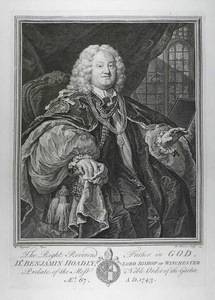| Method | Copper engraving and etching |
| Artist | Bernard Baron after William Hogarth |
| Published | W. Hogarth, Pinx. B. Baron, Sculp. 1743. [J & J Boydell c.1795] |
| Dimensions | Image 355 x 287 mm, Plate 430 x 300 mm, Sheet 645 x 470 mm |
| Notes |
A three-quarter length portrait by Bernard Baron after the painting by Hogarth of the 'political bishop' Dr. Benjamin Hoadly. Hoadly, a friend of Hogarth, was an active Whig, and the initiator of the Latitudarian Bangorian Controversy. Despite holding the Bishoprics of Bangor, Hereford, Salisbury, and eventually Winchester, Hoadly spent the majority of his time in London, owing to his various maladies and physical frailties. Despite his oft-mentioned ugliness, viciously elaborated upon by George II in a letter to Lord Hervey, Hogarth here depicts Hoadly in a sympathetic fashion, his oval face smiling benignly and his left hand raised in a gesture suggestive of a blessing. He wears the regalia of the Order of the Garter and sits upon a high-backed chair, a stained-glass window and heavy curtain behind him. An inscription below with the Bishops Crest reads: 'The Right Reverend Father in God, Dr. Benjamin Hoadly, Lord Bishop of Winchester, Prelate of the Most Noble Order of the Garter, Aet. 67. AD 1743.' Bernard Baron (1696 - 1762) was a London-based French engraver, best known as one of four Frenchmen employed by William Hogarth. Baron's initial collaboration with Hogarth was due to the series Marriage a-la-Mode, though he also assisted in engraving the Plates for Four Times of the Day, and reproducing engraved portraits after Hogarth's paintings. He is also known as an engraver of portraits after Van Dyck, Rubens, Holbein, and others. William Hogarth (1697 - 1764) was born in London, the son of an unsuccessful schoolmaster and writer from Westmoreland. After apprenticeship to a goldsmith, he began to produce his own engraved designs in about 1710. He later took up oil painting, starting with small portrait groups called conversation pieces. He went on to create a series of paintings satirising contemporary customs, but based on earlier Italian prints, of which the first was The Harlot's Progress (1731), and perhaps the most famous The Rake's Progress. His engravings were so plagiarised that he lobbied for the Copyright Act of 1735, commonly referred to as 'Hogarth's Act,' as a protection for writers and artists. During the 1730s Hogarth also developed into an original painter of life-sized portraits, and created the first of several history paintings in the grand manner. Paulson 226 i/i, O'Donoghue 3 Condition: Full margins, water stain to bottom half of sheet. |
| Framing | unmounted |
| Price | £85.00 |
| Stock ID | 38039 |

